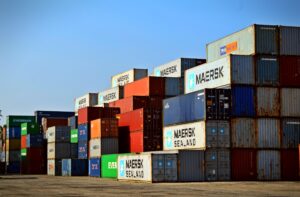This article comes from industryanalysts.com, you may read the whole article HERE.
Author Will Knight 25 March 2022.
The Supply Chain Crisis Is About to Get a Lot Worse
THE SUPPLY CHAIN is in chaos—and it’s getting worse. Air freight warehouses at Shanghai Pudong Airport are log-jammed. This is a result of strict Covid testing protocols imposed on China’s biggest city following a local outbreak. More than 120 container vessels are on hold at the city’s port, Shanghai-Ningbo.
In Shenzhen, a major manufacturing hub in the country’s south, trucking costs have shot up 300 percent. This is due to a backlog of orders and a shortage of drivers following the introduction of similar Covid restrictions. Major ports the world over, which used to operate like clockwork, are now beset by delays, with container ships queuing for days in some of the worst congestion ever recorded. The list goes on.

Navigating a World of Photocopier Supply Chain Crisis
More than a million containers were due to travel to Europe from China by train. However, on a route that goes through Russia, they must now make their journey by sea as sanctions bite. Russia’s invasion of Ukraine has also severed key supply lines for nickel, aluminum, wheat, and sunflower oil. This caused commodity prices to skyrocket. Countries in the Middle East and Africa that rely on produce from Ukraine are likely to experience serious food shortages in the coming weeks and months.
Some European automotive production lines have cut their output due to a shortage of wiring normally sourced from factories in Ukraine. If the pandemic, which triggered a surge in purchasing of goods, caused the global supply chain to buckle, Russia’s invasion of Ukraine and China’s continuing zero-Covid policy risk breaking it completely.
Supply Chain
The supply chain is too complex, interconnected, and fragile to be made completely immune to shocks. Especially ones as seismic as a global pandemic or a major war. But a new reality is forcing companies to adopt new strategies to keep goods moving. In this reality, backlogs and breakdowns are the new normal. This makes getting ahead of disruptions as early as possible more important than ever.
“We used to occasionally have black swan events,” says Richard Wilding, professor of supply chain strategy at Cranfield University in the UK, referring to rare and hard-to-predict occurrences that have major impacts. “The problem at the moment is we have a whole flock of black swans coming at us.” Wilding says managing a supply chain used to involve 80 percent dealing with predictability and 20 percent coping with surprises, numbers that have now flipped. And he says a growing number of companies are now using tools that provide greater visibility into the flow of goods, and which can sometimes predict potential choke points.
“You effectively need to have continual monitoring,” he says. In an age when everything is connected, the global supply chain—a mess of transportation routes connecting commodities to manufacturers to buyers—has until recently remained alarmingly analog. That was manageable in the before-times, but the age of constant supply chain disruption is sending companies scrambling for more data.
Everstream Analytics Company
Everstream Analytics is one company that gathers supply chain data by tapping into open source information, including shipping records, news reports, and social media, as well as data provided by customers that include logistics, shipping, and retail firms. Customers include DHL, Dupont, and BMW. Julie Gerdeman, the company’s CEO, says it employs analysts who try to predict trouble spots, but it also feeds the data it gathers into machine-learning models that are trained to find issues.
Everstream predicts, for example, that last week’s shutdown in Shenzhen will have ripple effects in terms of manufacturing backlogs, shipping delays, and congestion that are as big as those caused by the Suez Canal blockage in March 2021.
Various types of data can help build a picture of gridlock as it unfolds. For example, Windward specializes in maritime information sources. This includes shipping transmissions, satellite imagery, and port and container data to analyze supply chain trends and risks. Chris Rogers, principle supply chain economist at Flexport, a company that helps businesses move goods and provides live tracking data on their movements, says it isn’t enough to simply know where products are. “There’s a thriving industry building those kinds of predictive analytics,” he says.
